Firstly let us give a short description of the question ” What is a tree”? Trees are perennial plants with a significant main stem or trunk, which supports branches and leaves. They have a root system that anchors them in the ground and absorbs water and nutrients from the soil. Trees use photosynthesis to convert sunlight into energy, and their leaves play a vital role in this process. They provide oxygen, shade, and habitat for various organisms, and can also produce fruits and flowers. Trees come in many species and sizes, ranging from small shrubs to towering giants, like redwood. They contribute to ecological balance, air quality, and the overall health of an ecosystem.
Parts of a Tree Diagram
In Biology, a tree diagram shows how different species are related and how they have evolved over time. It’s like a family tree for plants or animals, showing how they branch out from common ancestors. The diagram includes parts like the crown, which represents the branches and leaves; the trunk, which connects the crown to the base; and the root system, which anchors the tree and helps it absorb nutrients. This diagram helps us understand the connections between various species.
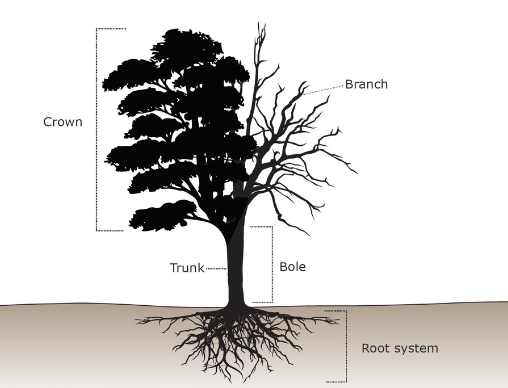
Functions of a Tree
The trees play many important roles in the maintenance of an ecosystem. Some of them are mentioned here.
- Oxygen Production: As we all know trees release oxygen as a byproduct of photosynthesis, which is very essential for the survival of many living organisms, including human beings.
- Carbon dioxide Absorption: Three absorb carbon dioxide from the atmosphere, helping to migrate the effect of climate change and reducing greenhouse gas levels.
- Habitat and Food: Trees provide habitats for various animals, insects, and birds, offering them shelter, nesting sites, and sources of food.
- Biodiversity Support: Trees contribute to biodiversity by hosting a wide range of species of Flora.
- Soil Erosion Prevention: The roots of the trees help anchor the soil, preventing erosion and maintaining a healthy ecosystem.
- Water Cycle: Through transpiration, threes release water vapors into the atmosphere, contributing to cloud formation and rainfall, thereby playing a role in the water cycle.
- Shade and Cooling: Trees offer shade, reducing the impact of heat in urban areas and providing a cooling effect through the process of transpiration.
- Timber and Resources: Trees provide valuable resources such as timber, wood products, fruits, nuts, and medicinal components.
- Carbon Storage: Trees store carbon in their biomass, helping to offset carbon emissions and mitigate the effects of climate change.
- Aesthetic and Recreational Value: Trees enhance the beauty of landscapes, parks, and natural areas, providing spaces for relaxation and recreation.
Parts of a Tree and their Functions
Trees are remarkable living entities comprised of various interconnected parts that work in harmony to facilitate their growth, survival, and contribution to the ecosystem. From their hidden roots to the towering branches, each component serves a distinct purpose from anchoring the tree to the soil, to capturing sunlight for energy production, to producing seeds for future generations. Understanding the intricacies of the tree’s anatomy allows us to appreciate within and around these arboreal wonders. A tree mainly has three main parts, which are named: the Crown, Trunk, and Roots.
| Parts of a Tree | |
| Name of the Parts | Description |
| Crown | It is the uppermost part of the tree which includes leaves, twigs, branches, fruits, and foliage, forming a canopy that captures sunlight for photosynthesis and provides habitat for various species. |
| Trunk | It is the central, vertical structure that supports all the parts of a crown, housing the vital vascular system responsible for transporting water, nutrients, and sugars through the tree. |
| Roots | They are the underground extensions of a tree’s structure that anchor it in the soil and absorb water and nutrients. They create a network to support the tree’s growth and stability. |
1. Crown
The crown of a tree is the uppermost part of the tree. It’s essentially the “top” or “head” of the tree. The crown is a vital component of a tree’s structure, as it serves as the powerhouse for the tree’s energy production, habitat for various organisms, and a contributor to ecological and environmental balance.
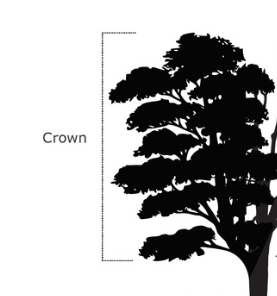
The crown’s structure and functions are integral to the tree’s overall health and its role in the ecosystem. The crown of a tree is composed of several distinct parts such as branches, leaves, twigs, flowers, fruits, and foliage that contribute to its structure and functions:
| Different Parts of a Crown | |
| Parts | Description |
| Branches | Branches are woody extensions from a tree trunk, bearing leaves, flowers, or fruits, providing structure and support within the tree. |
| Leaves | Leaves are plant organs that perform photosynthesis, capturing sunlight to convert into energy and releasing oxygen into the atmosphere. |
| Twigs | Twigs are small, slender branches or offshoots from a tree or shrub, often bearing leaves, flowers, or fruits in their growth. |
| Flowers | Flowers are reproductive structures of plants, containing male and female parts, essential for pollination and producing seeds and fruits. |
| Fruits | Fruits are mature ovaries and seeds of flowering plants, often sweet or savory, serving as a means of seed dispersal. |
| Foliage | Foliage refers to the collective mass of leaves on the plant, essential for photosynthesis, providing energy for the plant’s growth and development. |
1. Branches
These branches are the woody extensions that grow out from the main trunk of a tree, forming the framework of the crown. The branches are an important structural and functional component of a tree’s crown. These branches vary in size, length, and angles from the trunk. Branches support leaves, flowers, and fruits. They provide a platform for birds and animals.
Functions of a Branch
- Support and Structure: Branches provide structural support to the tree, holding up the crown and distributing its weight evenly. They also help maintain the tree’s overall shape and size.
- Photosynthesis: Branches bear leaves, which are very important for photosynthesis. Leaves capture sunlight and convert it into energy, which helps in the tree’s growth and metabolism.
- Reproduction: Some trees produce flowers and fruits on their branches. And as we all know flowers are the reproductive structures that develop into fruits containing seeds. These seeds allow the tree to reproduce and establish new individuals.
- Habitat: Branches serve as habitats for birds, insects, and animals. Birds often build nests in the crooks of branches, while insects find refuge among the leaves and bark.
- Air and Light Exposure: The branching structure of a tree’s crown determines how much air and light penetrate the interior of the crown, affecting the health and growth of leaves and other branches.
2. Leaves
The leaves are the primary site of photosynthesis. The leaves are flat, thin structures attached to the branches. They are of various shapes, sizes, and colors, optimizing for capturing sunlight and facilitating gas exchange.
Functions of Leaves
- Photosynthesis: Leaves are the primary sites of photosynthesis, where they use sunlight, carbon dioxide, and water to produce glucose and oxygen.
- Gas Exchange: Leaves facilitate the exchange of gases, allowing carbon dioxide to enter the leaf for photosynthesis and oxygen to exit.
- Transpiration: Leaves help in the process of transpiration, where water is drawn from the roots and evaporates from the leaf surfaces, aiding in the transport of water and nutrients throughout the plants.
- Storage: Some leaves store nutrients or water for the plant, acting as a storage organ.
- Absorption of Light: Leaves contain pigments like chlorophyll that capture light energy for photosynthesis.
3. Twigs
The twigs are smaller branches that extend from the larger branches. They carry leaves and, in some cases, they also carry flowers and buds. The twigs contribute to the overall volume and density of the crown.
Functions of Twigs
- Support: Twigs provide structural support to leaves, flowers, and fruits, holding them in place and maximizing their exposure to sunlight for photosynthesis.
- Transport: The vascular tissues within twigs, including the xylem and phloem, transport water, nutrients, and sugars between the roots and the rest of the tree.
- Environmental Interaction: Twigs provide a surface for various organisms like insects, birds, and lichens to attach and inhabit, creating microhabitats within the tree’s ecosystem.
- Sensory Perceptions: Twigs can sense environmental cues such as light direction, enabling leaves to orient themselves.
- Protection: Some twigs may have thorns, spines, or other defensive structures that deter herbivores or potential threats.
4. Flowers
Depending on the tree species, flowers can be part of the crown. They are the reproductive structures that further develop into fruits containing seeds with the help of fertilization. Flowers attract pollinators like insects or Birds which helps in the process of Pollination.
Functions of Flowers
- Pollination: Flower facilitates the transfer of pollen from the male reproductive parts (stamens) to the female reproductive parts (pistils) of the same or another tree, leading to Fertilization.
- Reproduction: the flowers are the reproductive structures of a tree. They contain the male parts (stamens) which produce pollen and the female parts (pistils) which contain ovules. Fertilization leads to the formation of seeds.
- Attracting Pollinators: Flowers use colors, fragrances, and nectar to attract pollinators such as bees, butterflies, birds, and insects, aiding in the pollination process.
- Seed Production: After successful pollination and fertilization, flowers develop into fruits that house and protect the seeds.
5. Fruits
Some of the trees bear fruits in their crown. The fruits house and protect the seeds, aiding in their dispersal. The fruits are also of various shapes, sizes, and colors, depending on the tree species.
Functions of Fruits
- Seed Protection: Fruits serve as a protective covering for seeds, shielding them from physical damage, pests, and harsh environmental conditions.
- Seed Dispersal: Fruits are a mechanism for plants to spread their seeds. Animals eat the fruits, and the seeds are dispersed to new locations through their digestive system or by sticking to their fur or feathers.
- Reproduction: Fruits are vital parts of a plant’s reproductive process. They contain seeds that, when dispersed and germinated, can grow into a new plant.
- Attracting Seed Dispersers: Fruits often have vibrant colors, pleasant aromas, and sweet tastes that attract animals, encouraging them to eat the fruits and subsequently disperse the seeds.
- Ecosystem Services: Fruits produced by trees are a part of the complex food web of interactions within the ecosystem, supporting various animals and contributing to the overall health of the environment.
6. Foliage
The foliage of a tree refers to its collective leaves, which are integral components of the tree’s crown. Foliage plays a vital role in the tree’s life cycle, contributing to its growth, energy production, and interaction with the environment. Leaves come in diverse shapes, sizes, and colors, adapting to the tree’s specific ecological compartments.
Functions of Foliage
- Photosynthesis: The foliage also helps in the process of photosynthesis. By converting sunlight into energy. This energy fuels the tree’s growth and metabolism.
- Nutrient cycling: As leaves fall and decompose, they contribute organic matter to the soil, enriching it with nutrients and supporting microbial life.
- Identification: The characteristics of a tree’s foliage, such as leaf shape, arrangement, and color, can help identify different tree species.
- Aesthetic and Cultural Value: Foliage enhances the visual appeal of the trees, creating lush green canopies that provide beauty and shade in urban and natural landscapes, many cultures celebrate the changing colors of the leaves.
- Environmental Impact: Through photosynthesis, foliage contributes to reducing the concentration of carbon dioxide in the atmosphere, thereby helping mitigate the effects of climate.
2. Trunk
The trunk of a tree is the central and main part of the tree’s stem. It provides support to the branches, leaves, and other parts of the tree. The trunk is made up of layers, including bark, cambium layer, and wood. It transports water and minerals from the roots to the rest of the tree and also helps store energy in the form of carbohydrates. By observing the trunk of a tree we can even find out the age of the tree. The size and shape of a tree’s trunk can vary depending on the species and environmental conditions.
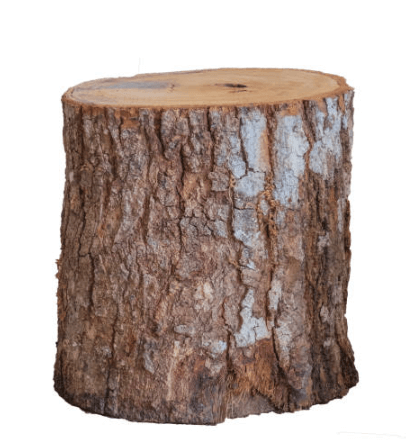
Functions of a Trunk
- Support: The trunk provides structural support to the tree’s branches, leaves, and other components, helping the tree stand upright.
- Transport: It serves as a conduit for transporting water and minerals absorbed by the roots up to the leaves and other parts of the tree through the xylem.
- Storage: The trunk stores energy in the form of carbohydrates produced through photosynthesis. These reserves can be tapped into during periods of growth or when environmental conditions are less favorable.
- Growth: The trunk’s cambium layer, a thin layer between the inner wood and outer bark, is responsible for cell division and growth, leading to the outward expansion of the trunk over time.
- Anchor: The tree trunk’s extensive root system anchors the tree securely in the soil, preventing it from being easily uprooted by wind or other forces.
- Indicator of Health: The condition of a tree’s trunk can provide insights into its overall health and well-being. Signs of disease, decay, or stress often manifest first in the trunk.
3. Roots
The roots of a tree are typically found underground and serve to anchor the tree in the soil, absorb water and nutrients, and store energy. The roots play a vital role in the tree’s overall health and stability. Roots system can vary based on the type of tree and the conditions in which it grows. Some trees have shallow, wide-spreading roots, while others have deep taproots. Additionally, roots can extend beyond the tree’s canopy, often referred to as the “dripline”, to maximize the area from which they can gather water and nutrients.
All roots are not visible, there are both larger structural roots and smaller, fine root hairs responsible for nutrient absorption. These root hairs are tiny, finger-like extensions on the plant roots that significantly increase surface area. They enhance water and nutrient absorption from the soil, aiding plant growth and the health of the tree. Overall, the health of a tree is closely tied to the health of its root system.
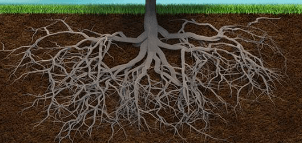
Functions of Roots
- Preventing Soil Erosion: The network of roots helps bind the soil together, preventing erosion and maintaining the structure of the surrounding environment.
- Interactions with Microorganisms: The root zone is a hotspot for various microorganisms that contribute to the health of the tree. Some form beneficial symbiotic relationships, like mycorrhizal fungi, which assist in nutrient uptake.
- Anchoring and Support: The primary function of the roots is to anchor the tree firmly in the soil, providing stability against wind, rain, and other environmental forces.
- Water and Nutrient Absorption: Roots absorb water and essential nutrients from the soil. These nutrients, such as nitrogen, phosphorus, and potassium, are crucial for the tree’s growth and overall health.

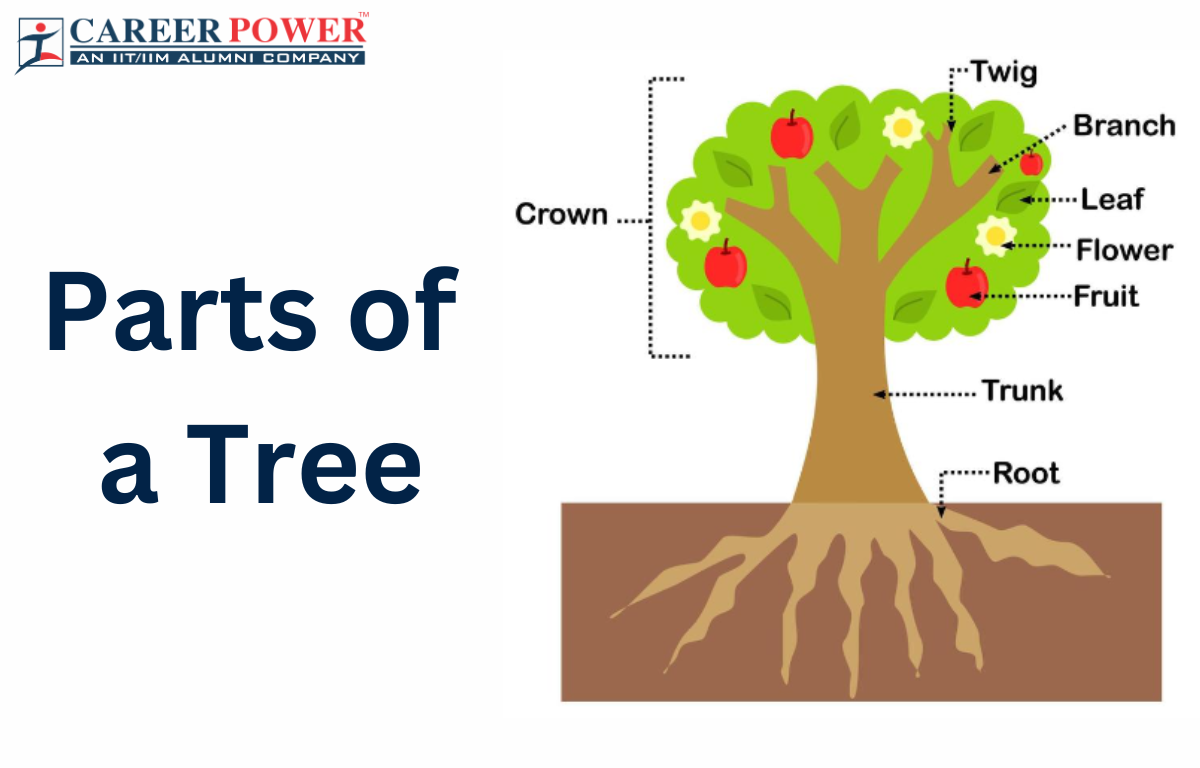

 50 Vegetables Name for Kids in English a...
50 Vegetables Name for Kids in English a...
 Food Chain: Definition, Types, Examples,...
Food Chain: Definition, Types, Examples,...
 Human Respiratory System: Definition, Di...
Human Respiratory System: Definition, Di...













